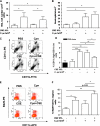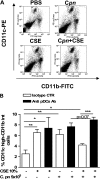Plasmacytoid dendritic cells prevent cigarette smoke and Chlamydophila pneumoniae-induced Th2 inflammatory responses
- PMID: 19901344
- PMCID: PMC2951872
- DOI: 10.1165/rcmb.2009-0224OC
Plasmacytoid dendritic cells prevent cigarette smoke and Chlamydophila pneumoniae-induced Th2 inflammatory responses
Abstract
Smoking promotes the development of allergic asthma and pneumonia. Chlamydophila pneumoniae lung infection is associated with an increased risk for asthma, inducing an immune response regulated by dendritic cells (DCs). This study sought to determine whether exposure to cigarette smoke modulates the functional activity of CD11c-positive DCs in the lung, with and without concomitant C. pneumoniae infection. Bone marrow-derived DCs (BMDCs) were exposed in vitro to cigarette smoke extract (CSE) and/or live C. pneumoniae (Cpn), and then adoptively transferred intratracheally into wild-type mice. Although CSE plus Cpn appeared to exert an additive effect on the production of Th2 cytokines in vitro, we did not see this effect in vivo. However, the adoptive transfer of DCs pulsed with both CSE and C. pneumoniae into the lungs of naive mice led to an influx of plasmacytoid DCs (pDCs) that suppressed the Th2 skewing ability of the transferred BMDCs. The depletion of pDCs by antibody restored the Th2 skewing ability of the BMDCs. The expression of indoleamine-2,3-dioxygenase in the lung was reduced after the depletion of pDCs, and blocking IFN-α in vitro prevented the ability of pDCs to inhibit the Th2 responses induced by myeloid DCs (mDCs), suggesting their potential involvement in the mechanism of altered polarization. In conclusion, exposure to cigarette smoke skews C. pneumoniae-induced mDCs responses toward a Th2 bias in the lung, which is prevented by pDCs. We propose that pDCs may play a major role in the immunosuppressive lung environment in smokers with C. pneumoniae infection.
Figures







Similar articles
-
Critical role of IL-6 in dendritic cell-induced allergic inflammation of asthma.J Mol Med (Berl). 2016 Jan;94(1):51-9. doi: 10.1007/s00109-015-1325-8. Epub 2015 Aug 2. J Mol Med (Berl). 2016. PMID: 26232935
-
Innate immune processes are sufficient for driving cigarette smoke-induced inflammation in mice.Am J Respir Cell Mol Biol. 2010 Apr;42(4):394-403. doi: 10.1165/rcmb.2008-0301OC. Epub 2009 Jun 5. Am J Respir Cell Mol Biol. 2010. PMID: 19502389
-
Chlamydia pneumoniae infection induced allergic airway sensitization is controlled by regulatory T-cells and plasmacytoid dendritic cells.PLoS One. 2011;6(6):e20784. doi: 10.1371/journal.pone.0020784. Epub 2011 Jun 10. PLoS One. 2011. PMID: 21695198 Free PMC article.
-
Dendritic cells, indoleamine 2,3 dioxygenase and acquired immune privilege.Int Rev Immunol. 2010 Apr;29(2):133-55. doi: 10.3109/08830180903349669. Int Rev Immunol. 2010. PMID: 20367139 Free PMC article. Review.
-
Distinct dendritic cell subsets actively induce Th2 polarization.Curr Opin Immunol. 2014 Dec;31:44-50. doi: 10.1016/j.coi.2014.09.006. Epub 2014 Oct 4. Curr Opin Immunol. 2014. PMID: 25290173 Free PMC article. Review.
Cited by
-
Sputum microbiota as a potential diagnostic marker for multidrug-resistant tuberculosis.Int J Med Sci. 2021 Mar 3;18(9):1935-1945. doi: 10.7150/ijms.53492. eCollection 2021. Int J Med Sci. 2021. PMID: 33850462 Free PMC article.
-
Plasmacytoid dendritic cells play a role for effective innate immune responses during Chlamydia pneumoniae infection in mice.PLoS One. 2012;7(10):e48655. doi: 10.1371/journal.pone.0048655. Epub 2012 Oct 31. PLoS One. 2012. PMID: 23119083 Free PMC article.
-
Association analyses identify multiple new lung cancer susceptibility loci and their interactions with smoking in the Chinese population.Nat Genet. 2012 Jul 15;44(8):895-9. doi: 10.1038/ng.2351. Nat Genet. 2012. PMID: 22797725 Free PMC article.
-
Cigarette Smoke Increases CD8α+ Dendritic Cells in an Ovalbumin-Induced Airway Inflammation.Front Immunol. 2017 Jun 16;8:718. doi: 10.3389/fimmu.2017.00718. eCollection 2017. Front Immunol. 2017. PMID: 28670318 Free PMC article.
-
Clinical view on the importance of dendritic cells in asthma.Expert Rev Clin Immunol. 2013 Oct;9(10):899-919. doi: 10.1586/1744666X.2013.837260. Expert Rev Clin Immunol. 2013. PMID: 24128155 Free PMC article. Review.
References
-
- Chalmers GW, MacLeod KJ, Thomson L, Little SA, McSharry C, Thomson NC. Smoking and airway inflammation in patients with mild asthma. Chest 2001;120:1917–1922. - PubMed
-
- Hylkema MN, Sterk PJ, de Boer WI, Postma DS. Tobacco use in relation to COPD and asthma. Eur Respir J 2007;29:438–445. - PubMed
-
- Reibman J, Hsu Y, Chen LC, Bleck B, Gordon T. Airway epithelial cells release MIP-3α/CCL-20 in response to cytokines and ambient particulate matter. Am J Respir Cell Mol Biol 2003;28:648–654. - PubMed
-
- Naiki Y, Sorrentino R, Wong MH, Michelsen KS, Shimada K, Chen S, Yilmaz A, Slepenkin A, Schröder NW, Crother TR, et al. TLR/MyD88 and liver X receptor alpha signaling pathways reciprocally control Chlamydia pneumoniae-induced acceleration of atherosclerosis. J Immunol 2008;181:7176–7185. - PMC - PubMed
Publication types
MeSH terms
Substances
Grants and funding
LinkOut - more resources
Full Text Sources
Molecular Biology Databases
Research Materials

